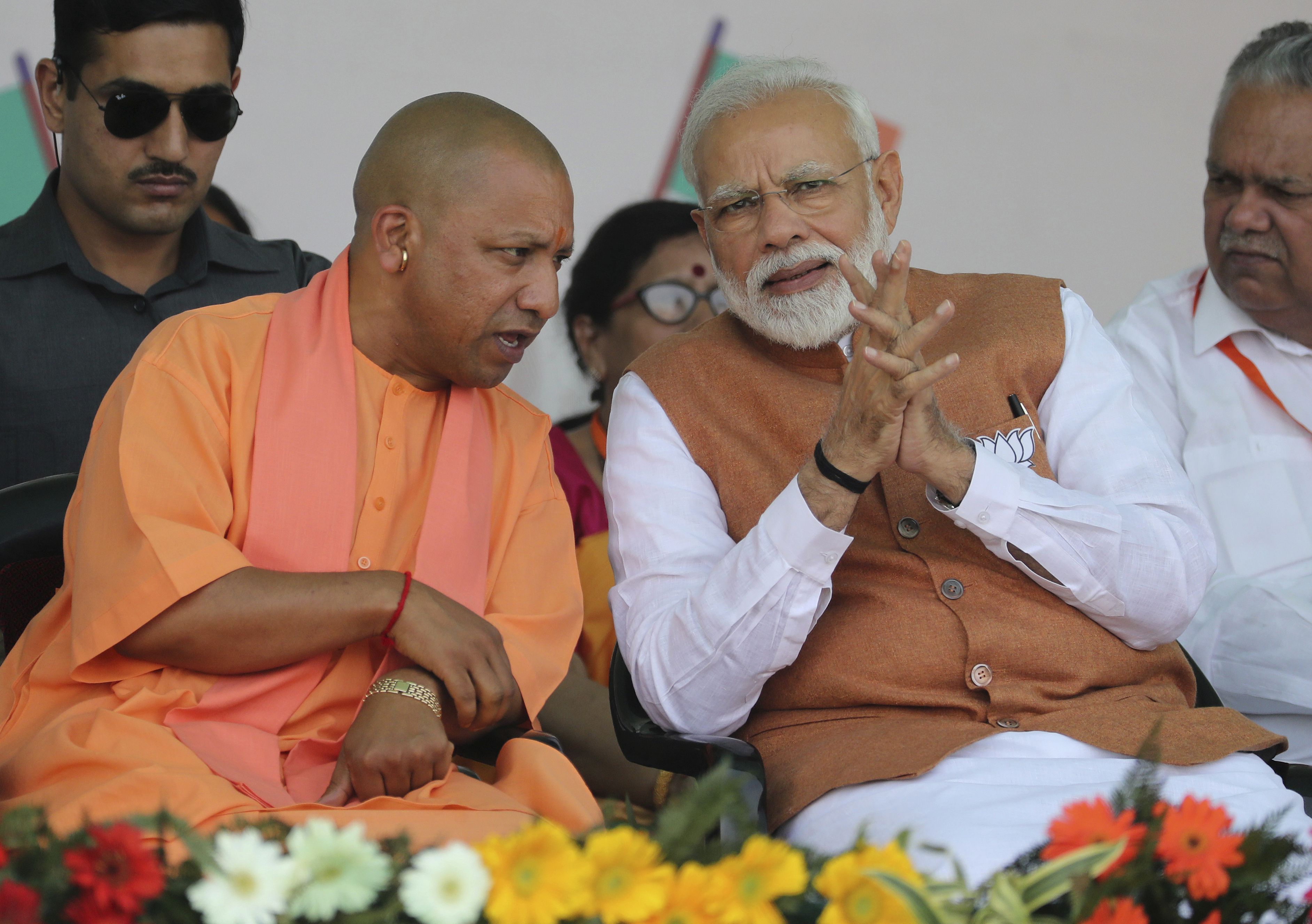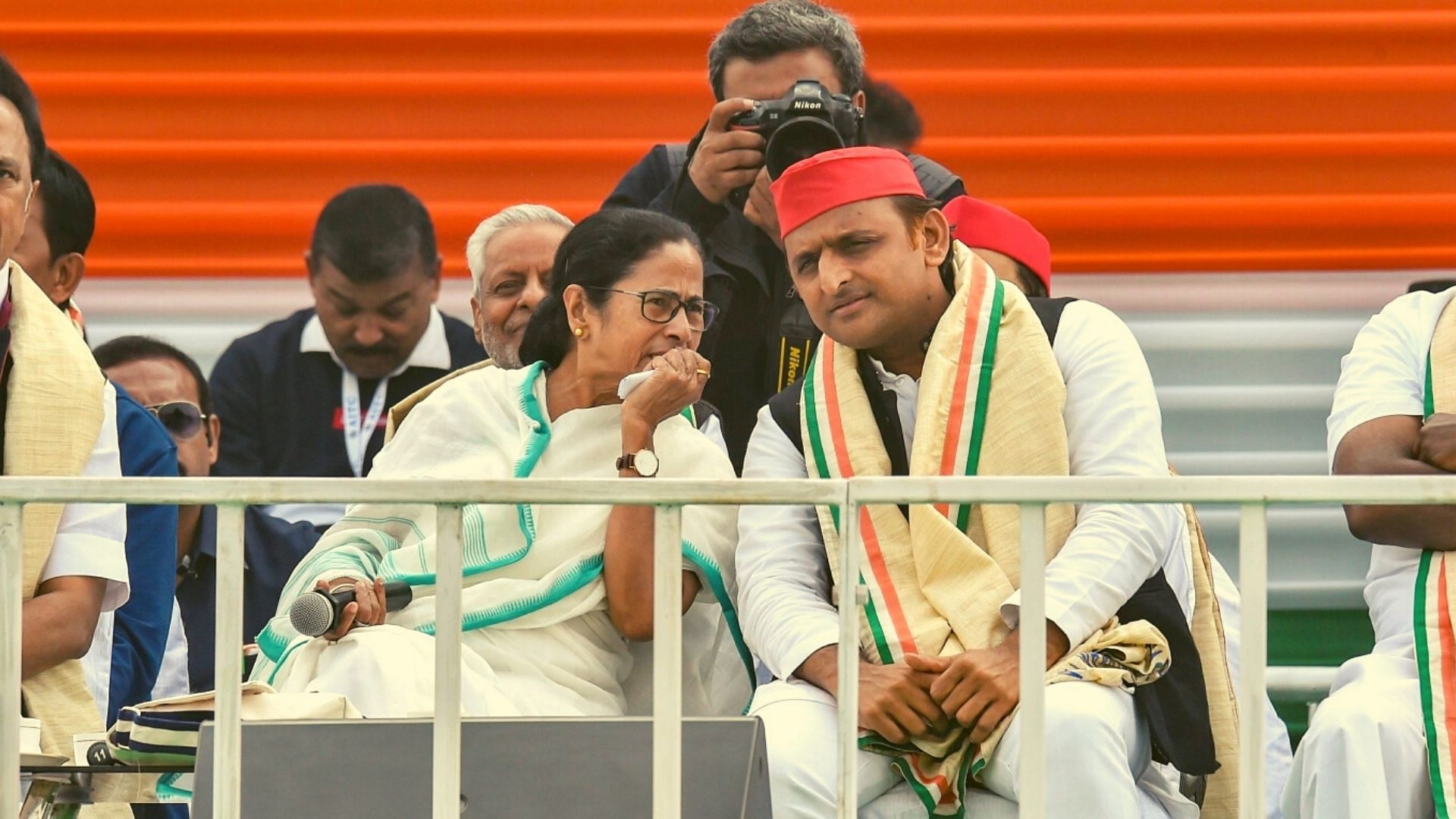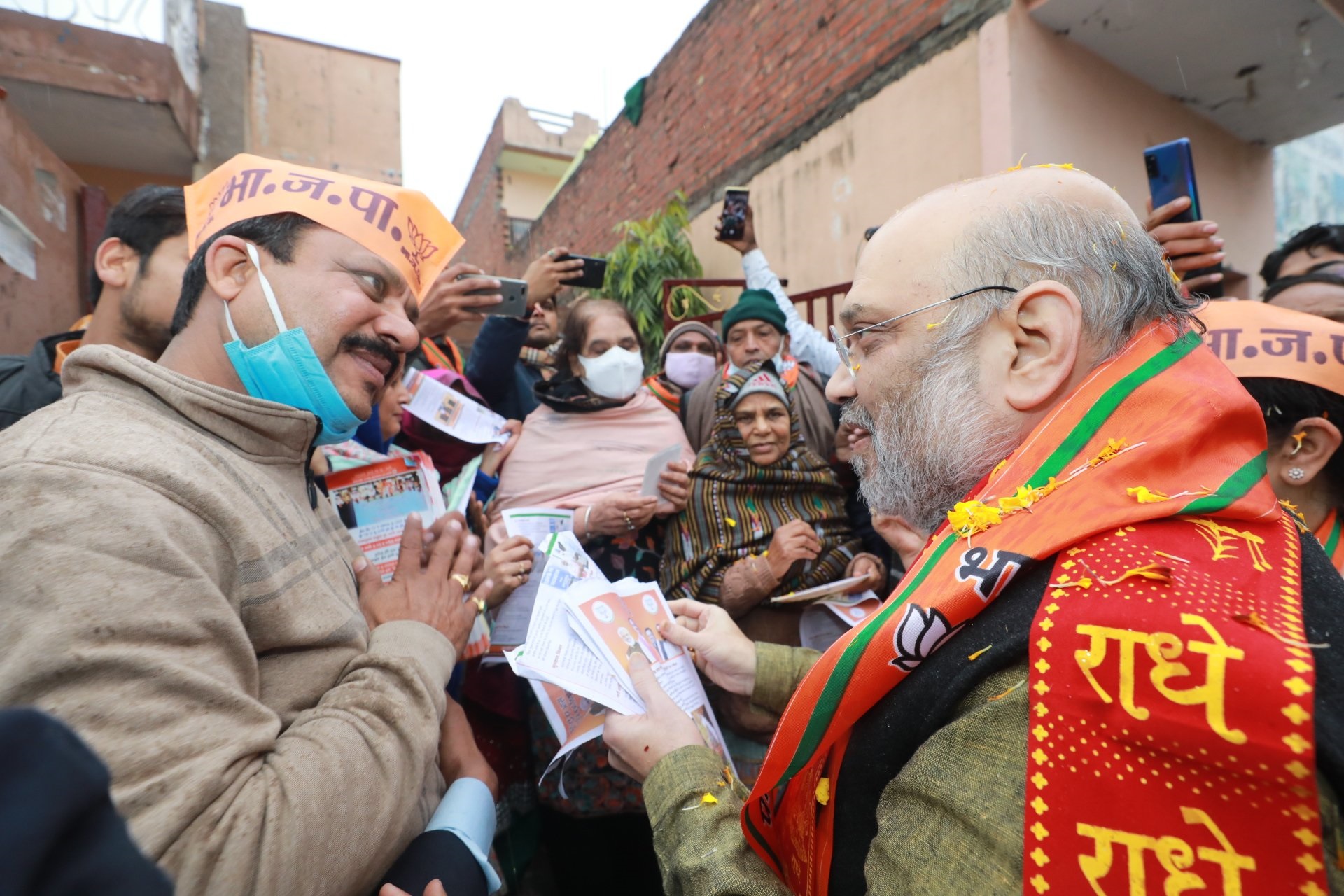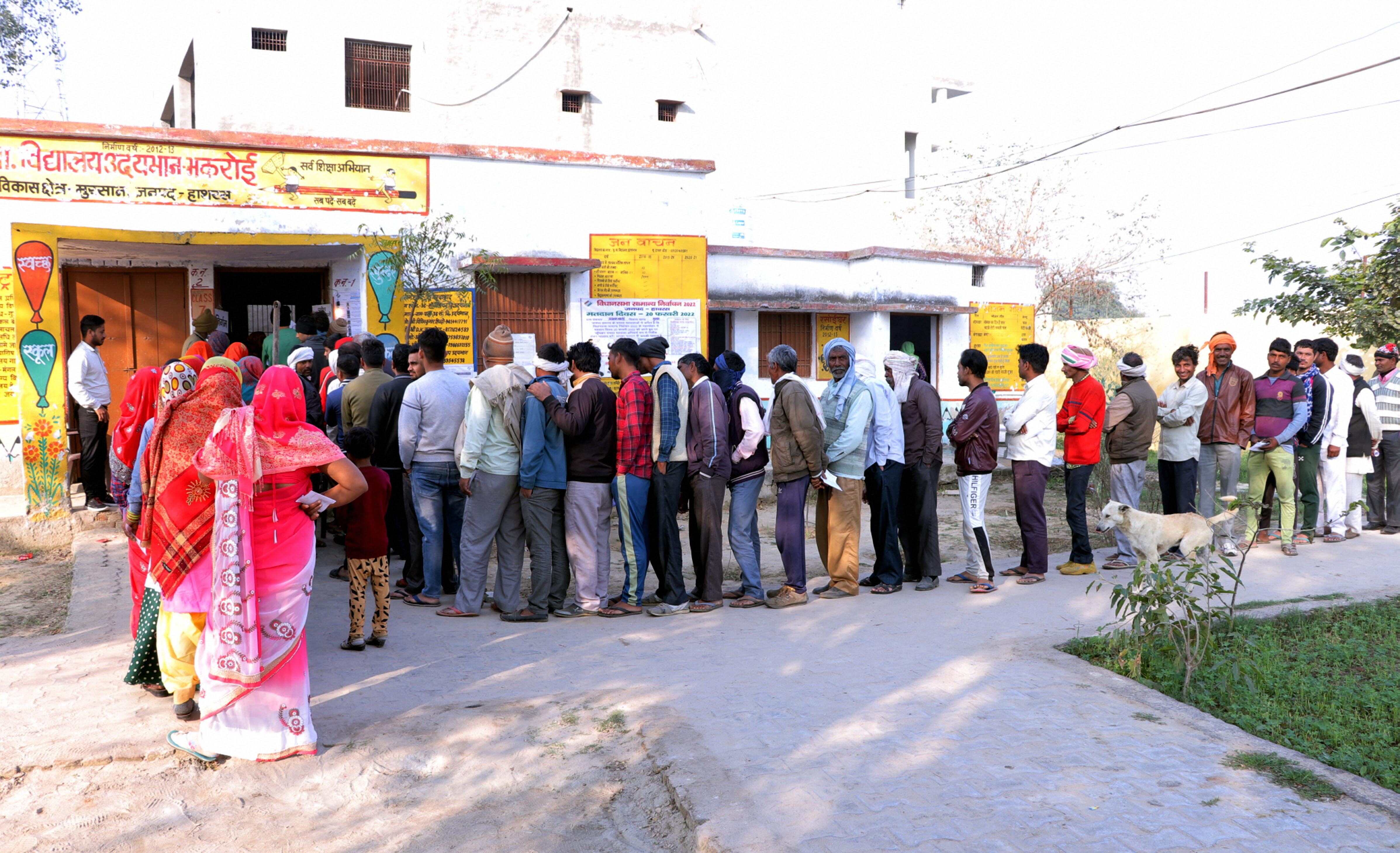
Prime Minister Narendra Modi has attacked his opponents below the belt in an aggressive language in his public addresses, reflecting his desperation amid reports that the BJP is losing ground in the on-going seven-phased assembly elections in Uttar Pradesh, reports Mudit Mathur
Why the Prime Minister of India, Narendra Modi adopted all sorts of poll gimmicks in seven phased assembly elections of Uttar Pradesh? He attacked his opponents below the belt in an aggressive, uncouth language during his negative campaigning. The PM’s public addresses reflect his shaky mindset with deep sense of insecurity and desperation. The completion of fourth phase polls do not inspire enough hope for the double engine ruling party – which has the highest nation-wide stakes from this state in 2024 general elections. Apart from the wide range of implications that includes the upcoming presidential elections in July, where in the President Ram Nath Kovind has to demit his office.
In any event, the Uttar Pradesh assembly elections would set the tone and direction for the 2024 general elections of Lok Sabha as the gateway to the top throne of power. If BJP comes with overwhelming majority, then surely the credit of victory will go to Modi – Yogi led double engine governments. It will be considered as reimposition of faith of the people in their leadership and policies. In case, it forms government with a fractured mandate with the help of smaller coalition partners or outside or inside support of BSP, then in all probabilities the Uttar Pradesh will see a new guard in place of Yogi Adityanath, presumably either from the most backward or Dalit caste.

However, if the anger of the people translates into the formation of a non-BJP government with SP alliance, then it would be the biggest blow to the saffron plans enabling the continuance of Modi rule beyond 2024.This might give an opportunity to his detractors to challenge his unquestioned authority within the party, and the government. The political circles are keenly monitoring the changing dynamics of the saffron attired monk, the young leader, Yogi Adityanath, who is often perceived as a horse of long race from North India with a nationwide reach. His admirers see him as a potential competitor of Modi for the top job, if he brings overwhelming majority in ongoing polls. However, it just seems as an irrational, wishful thinking.
Now, the polling trail is moving towards the eastern region after the polling held on 232 seats out of 403 assembly segments. Prime Minister Narendra Modi and Chief Minister Yogi Adityanath – both comes from this region, which makes it interesting to observe how people of their area assess their contribution. Further, it helps in evaluating how voters’ respond to the much-hyped Ayodhya temple, and Kashi Vishwanath corridor projects on the political turf – overriding issues of livelihood, price rise and shrinking income of common man due to economic recession.
The interactive responses of mass anger are worth noticing over menace of stray cattle, price rise, farmers’ distress, Covid-19 mismanagement, growing unemployment and handling of farmers’ agitations oppressively and violently in Lakhimpur Kheri , which frequently got reflected during mammoth rallies of opposition leaders. These leaders continued to highlight the mass miseries and failures of the government. It kept on scratching the fresh woes of the people which still haunt them with sheer helplessness.
Besides, free ration and a kilogram of ghee for the next five years, Akhilesh Yadav promised jobs to the youth by filling more than a million vacant government jobs and restoration of old pension scheme for the state employees, which gave him big support base in the elections. While promising free electricity up to 300 units, he promised to triple the pension of women and laptop and smartphones to students as he gave during his chief ministership. He also promised free irrigation facilities and minimum support price of all the crops and strengthening of procurement government network.
The claim of emergence of a new support base of beneficiaries of much-hyped flagship schemes of Modi-Yogi government – who enjoyed benefits of free ration, PM-CM housing, toilets and pension schemes, seems to be swayed away due to their inherent commitment to caste identities. Caste still play significant role in the elections despite availing benefits of welfare schemes. The voters of the Bahujan Samaj Party are almost intact with Mayawati whose gamble fielding Muslims so making a dent in the prospects of Samajwadi Party appears to have failed. The phenomenon appeared to have been designed to help BJP to grow its tallies.

The slanderous indecorous vocabulary of no holds barred, followed with senseless overheated speeches by the top leaders of saffron brigade, have gradually overshadowed the perception of any storm or wave on the grounds in their favour, largely because people are fed up with this kind of communal rhetoric and want a change for development and affirmative action ensuring social justice to oppressed people.
The trio – Modi, Shah and Yogi — is dubbing Samajwadi Party as dynastic party of goons and blamed them for providing protection to criminals and creating an atmosphere of lawlessness when in power. The trio even blamed them for going to the extent of withdrawing cases against the terror accused. The BJP leaders aimed at making the larger political narrative of law and order and domination of a particular caste associated with the SP to check against any possible exodus from its ranks. However, the BJP’s high-pitched campaign on the issue of terrorism and “Tamanchawadi” has not left much impact on the public minds.
The battle of Uttar Pradesh has reached a turning point and is looking very tough for the BJP. As initially it estimated like a cakewalk by none other than chief minister Yogi Adityanath – calling it between 80 versus 20 battle while aiming at communal polarisation. The branding of Yogi Adityanath has been meticulously promoted by RSS family as a mascot of hardcore Hindutva with ferocious style to generate communal polarisation. Not only 80 percent versus 20 percent remark – he went on and on creating religious frenzy aimed at ridiculing Muslims at large. He brought Ali-Bajrangbali remark in West Bengal elections. Once he had said that Hanumanji belonged the tribal community.
Adityanath, 49, has been elected five times as Member of the Parliament from Gorakhpur constituency. He represented this constituency in the Lok Sabha since 1998 when he was just 26-year old. He is contesting first time for state assembly and is presently a member in legislative council. Yogi hogged the nationwide limelight for his “GharWapsi” and “Love Jihad” campaigns designed to target Muslims who had done inter-religion marriages. Most blatantly, he warned people if they don’t vote BJP to power then UP could turn into Kashmir, Kerala or Bengal where it had failed to play Hindutva card over Muslim appeasement in the recent elections.
The menace of stray bulls and animals in rural areas which is giving sleepless nights to the farmers has become a bigger poll issue. The farmers barricaded their fields with fencing barbs resulting in serious injuries to animals. Prime Minister Narendra Modi had to come forward for damage control promising of handling the issue after the elections in a beneficial manner for them. Lately, Yogi also promised Rs 900 per month to those who adopt such cattle. Practically speaking, it is impossible to feed a cattle with a meagre amount of just Rs. 30/day whereas actual cost comes to Rs.150-200/day. Thus, such support is not enough to wipe off the tears of farmers whose crops have been ruined due to stray cattle.
The western region was epicentre of farmers agitation who went back empty handed from Delhi borders, mocking victory amid feelings of humiliation and bitterness because of harsh behaviour they were meted out by the Modi government, and its fire-brand sycophant leaders called them as anti-national, Khalistani and Andolanjeevi. Thus, it was their turn to pay back in the same coin by reversing the saffron tide to group on the wings of religious polarisation from most crucial state. The Sanyukt Kisan Morcha leaders Rakesh Tikait, Shiv Kumar Sharma ‘Kakkaji’, Yogendra Yadav are just asking people to punish those who are against farmers. They will visit Prayagraj, Gorakhpur and Varanasi in Uttar Pradesh ahead of polls in these districts.
BJP rose to power in 2014, 2017 and 2019 on the strength of sharp division among Jat and Muslims as an aftermath of 2013 communal riots in Muzaffarnagar but farmers agitation reunited them, cementing their age-old harmony of mutual brotherhood. The BJP mastermind Amit Shah ignited old pitch through his high-profile campaign in the western areas, invoking exodus of Hindus from Kairana, allegedly due to torture by Muslim goons who were money extortionists. They targeted SP nominee Nahid Hasan and sent him to jail. But this time the public response was not encouraging enough to indicate towards repetition of past performance and results will spring surprises in this belt. But BJP top leaders still believe that by and large their tally of 2017 will remain unchanged.
After the first and second phase in western and Rohilkhand areas, mainly dominated by Jat-Muslim equations, third phase in central Uttar Pradesh and Bundelkhand, the battlelines are clearly visible by and large suggesting a bipolar contests between Samajwadi Party and ruling BJP, at some places BSP is in the fray – with a decisive presence of Yadav, other OBCs and Muslim on most of the seats. But at the same time Congress and BSP nominees could pose good fights in some constituencies where interesting triangular or multi-cornered contest could spring surprise.
In 2017, the ruling Bharatiya Janata Party swept the region by winning 50 seats. The saffron outfit’s new caste consolidation has surprisingly demolished the Samajwadi Party in the Yadav heartland. The wave swept away the Bahujan Samaj Party in Bundelkhand and had dominated the elections in the urban stronghold of Kanpur region.
Apart from Yadav heartland–Firozabad to Etawah, Mainpuri and Auraiya, the Samajwadi Party alliance performed fairly well so far, until the fourth phase, as compared to last elections– mainly because heavy anti-incumbency against double engine BJP government. Akhilesh Yadav himself is a candidate from Karhal in Mainpuri where BJP fielded one of its heavyweight central minister S.P.Singh Baghel, who once happened to be a personal security officer of Mulayam Singh Yadav who inducted him in his party for contesting to Lok Sabha elections from Jalesar where he won three times as SP nominee.

Thereafter, politically ambitious Baghel defected to BSP and got nominated to Rajya Sabha (2010-2014) and thereafter, he joined BJP and won from Tundla assembly seat in 2017 and become a cabinet minister in Yogi government. Meanwhile BJP fielded him again for 2019 parliamentary elections and he won the Agra seat. Prime Minister Narendra Modi inducted him as a Minister of State for Law and Justice in the last cabinet reshuffle.
In the last assembly elections Samajwadi Party was entangled in a bitter family feud and suffered heavy losses in the third phase constituencies but this time message of unity was displayed publicly with its patriarch figure and founder of the party Mulayam Singh Yadav addressing a massive election rally in support of his son in Karhal in presence of his uncles with bonhomie in display. A few days later, Mulayum Singh Yadav, party chief Akhilesh Yadav, his wifeDimple Yadav, Rajya Sabha member Ram Gopal Yadav, former UP minister Shivpal Yadav and former MP Dharmendra Yadav reached their native village Safai to cast vote. In the third phase of UP Polls, Akhilesh Yadav is contesting from Karhal while his uncle Shivpal Yadav from Jaswant Nagar which is traditional seat represented by Mulayam Singh Yadav.
Bundelkhand consists of consolidation of non-Yadav other backward castes and Dalits. The non-Yadav OBC and the Dalits will also be the big deciding factor in the five districts of Jalaun, Hamirpur, Mahoba, Jhansi and Lalitpur in Bundelkhand. In all, 17 out of 19 seats of Bundelkhand have voted so far including four in Banda.
In the fourth phase polling on the 59 seats in nine districts held which include Lucknow, Sitapur, Hardoi, Unnao, Rae Bareli and Fatehpur in the Awadh region, Pilibhit and Lakhimpur Kheriin Terai belt of Rohilkhand and a seat Banda in Bundelkhand.The Rae Bareli district is known as bastion of Gandhi family represented by Congress president Sonia Gandhi where her party is in worst shape. Two of its MLA defected to BJP recently kidling hopes of BJP which failed to win any seat in last elections despite peak of saffron wave. Though Priyanka Gandhi extensively campaigned to save her stronghold but only poll results will show the impact of her appeal amid tricky caste calculations.
Lakhimpur Kheri is another district that hogged national attention over mowing down of farmers by Ashish Mishra Monu, son of sitting MoS Ajay Mishra Teni where BJP won all the eight seats in 2017 elections. The impact of this incident can result in heavy losses for the ruling BJP. Even Prime Minister Narendra Modi had to cancel his rally in this belt on 20th February following advice of intelligence agencies about possibility of security threat. The BJP leaders are not receiving favourable response in their door-to-door campaigns.
Lucknow has been considered as a stronghold of BJP ever since it elected Atal Behari Vajpaiyee to Lok Sabha. His legacy has been carried forward by Lalji Tandon and now Defence Minister Rajnath Singh. In the last assembly elections, the BJP won eight out of nine seats from here. One seat went to Samajwadi Party. Lucknow recorded about 61percent polling but the current scenario suggests loss in its previous tally as Samajwadi Party is substantially challenging its might. Similar feedbacks are pouring in from Hardoi, Sitapur, Unnao, Fatehpur where ruling BJP is facing strong anti-incumbency.
Priyanka’s women initiative noteworthy
Despite its previous failures in direct fight with BJP, the Congress party for the first time after demolition of Babri mosque is contesting elections without pre-poll tie up with any party. Priyanka Gandhi is trying hard to galvanise grand old Congress party for 2024 parliamentary elections. Her focus is to restructure her party at grassroots. She took the lead to set the vision agenda for women, youth, farmers and welfare measures for society aimed at empowering every section. Her initiative fielding 40 percent women in elections will prove to be a milestone in changing the quality of politics.
Now with the conclusion of fourth phase, now battle of votes moved towards banks of Saryu in Ayodhya and eastern belt. While Rakesh Tikait spoiled the prospects of BJP in the western UP, the command of of eastern UP has been in the hands of Om Prakash Rajbhar, who spearheaded consolidation of non-Yadav OBCs and non-Jatav Dalits together under the umbrella of Samajwadi Party. His utterances in local Bhojpuri dialect attracted huge crowd and created much discomfort to Modi-Shah and Yogi in areas of their influence. So real wrestling of Mandal versus Kamandal will dominate the political scenes in this belt.











